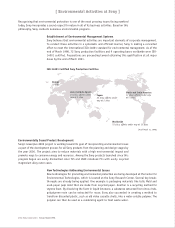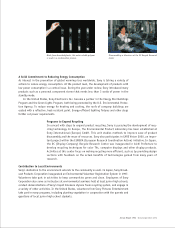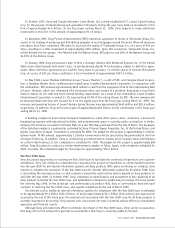Sony 1998 Annual Report Download - page 39
Download and view the complete annual report
Please find page 39 of the 1998 Sony annual report below. You can navigate through the pages in the report by either clicking on the pages listed below, or by using the keyword search tool below to find specific information within the annual report.
Annual Report 1998 Sony Corporation [37]
Made from discarded plastic, this water-soluble polymer
is used in a condensation process.
Disassembling a television at the DC Recycle Research
Center
A Solid Commitment to Reducing Energy Consumption
As interest in the prevention of global warming rises worldwide, Sony is taking a variety of
actions to reduce energy consumption. At the product level, the development of products with
low power consumption is a central issue. During the year under review, Sony introduced many
products such as a personal component stereo that needs less than 3 watts of power in the
standby mode.
In the United States, Sony Electronics Inc. became a partner in the Energy Star Buildings
Program and the Green Lights Program, both being promoted by the U.S. Environmental Protec-
tion Agency. To reduce energy for heating and cooling, the roofs of company buildings are
coated with a reflective, heat-resistant paint. Energy-efficient lighting fixtures and other steps
further cut power requirements.
Programs to Expand Recycling
In concert with steps to expand product recycling, Sony is pursuing the development of recy-
cling technology. In Europe, The Environmental Product Laboratory has been established at
Sony International (Europe) GmbH. This unit studies methods to improve ease of product
disassembly and the reuse of resources. Sony also participates in CARE Vision 2000, an impor-
tant project within the EUREKA (European Research Coordination Action) initiative. In Japan,
the DC (Display Company) Recycle Research Center was inaugurated in Aichi Prefecture to
develop recycling techniques for color TVs, computer displays and other display products.
Activities at this center focus on making recycling more efficient, such as by providing design
sections with feedback on the actual benefits of technologies gained from many years of
research.
Contribution to Local Environments
Sony’s dedication to the environment extends to the community as well. In Japan, Sony Broad-
cast Products Corporation inaugurated an Environmental Volunteer Registration System in 1997.
Volunteers take part in activities to keep communities green and clean. Employees of Sony
Corporation also serve as instructors at environmental seminars held at local junior high schools,
conduct demonstrations of Sony’s liquid limonene styrene foam recycling system, and engage in
a variety of other activities. In the United States, volunteers from Sony Pictures Entertainment
take part in many programs, including planting vegetation in cooperation with the parents and
guardians of local junior high school students.
























